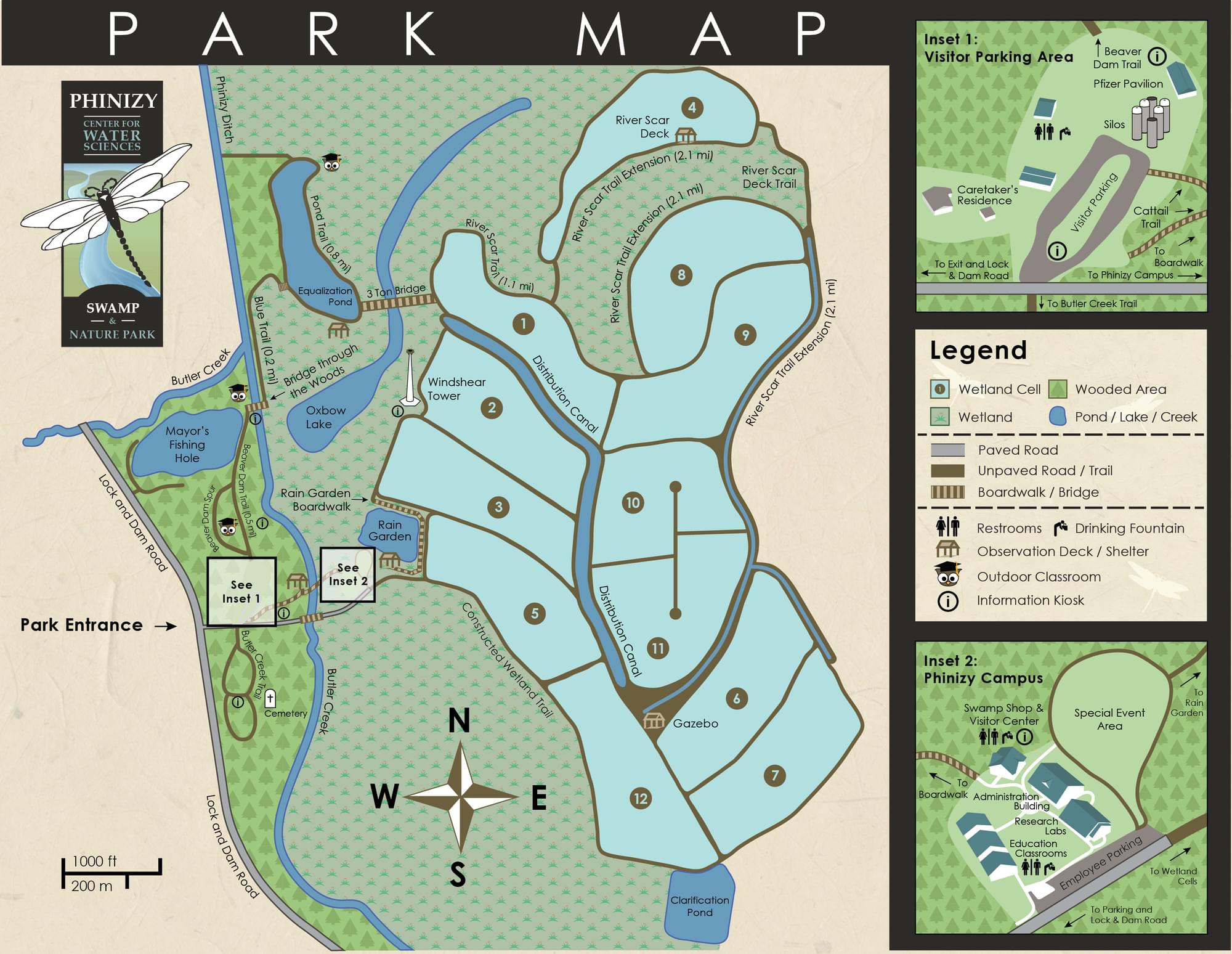Phinizy Swamp Nature Park

Phinizy Swamp Nature Park
Tips for Birding
Peak birding season occurs in late winter and early spring. 80-100 species can be found in a day during this period with a good itinerary and suitable weather. A common loop to take starts at the silos at the parking lot, hiking slowly through the Beaver Dam Trail early in the morning for woodland species to the Pond Trail, where waterfowl and neotropical migrants abound. From here, take the 3 Ton Bridge to the Distributional Canal, where shorebirds, sparrows, and palm warbler may be present, and bird various levees back to to the Phinizy Center Campus and Cattail Trail.
Birds of Interest
Phinizy Swamp Nature Park hosts a large variety of waterfowl species, including ducks, grebes, geese, wading birds, shorebirds, and occasionally pelicans, gulls, and terns.
Some of the more frequently targeted birds and tips of where to find them are listed below:
Black-bellied Whistling-Duck: (Apr-Dec, peak in spring and summer), commonly seen flying over Cattail Trail or in various wetland cells of the Constructed Wetland Trail
Canvasback: (Nov-Mar), infrequent in Rain Garden Pond or Equalization Pond
King Rail: (Year-round, peak Mar-Aug), very common vocalizing in all wetland cells. Often easily seen at 3 Ton Bridge and (during summer) on the wetland levees of the Constructed Wetland Trail with juveniles. Very responsive to playback.
Virginia Rail: (Oct-Apr, peak Nov-Feb), can be heard throughout wetland cells, but most frequently in cells 5, 3, and 2. Listen for high-pitched "kik" or "kik-deer" at dusk or pig-grunt rattle, lower-pitched and whinier than King Rail. Often responsive to playback.
Shorebirds: (peak Apr-May, Aug-Sep), shorebirds numbers coincide with low water levels in wetland cells and distributional canal.
Wood Stork: (Apr-Nov, peak Jul-Sep), often in Rain Garden Pond or in Butler Creek viewable from Cattail Trail or Butler Creek Trail. Look for soaring birds, especially in late summer.
American Bittern: (Oct-May, peak in spring), can be seen in close proximity to the boardwalk on Cattail Trail or at the 3 Ton Bridge. In the wetland cells or Rain Garden Pond look for large bulky birds flying low over cattails at dusk.
Least Bittern: (Apr-Aug, peak May-June), frequently seen and heard in wetland cells, especially Cells 5 and 12. Listen for cooing call early in morning and look for small stocky herons flying low over cattails (beware similar, darker Green Heron).
Tricolored Heron: (Jul-Oct, peak Jul-Sep), common throughout wetlands and Equalization Pond, particularly Distributional Canal. Almost entirely juveniles during post-breeding dispersal.
Osprey: look for nest on Windshear Tower.
Bald Eagle: (Sep-May, peak winter), check oxbow lakes and constructed wetland cells for large raptors on tall, dead cypress trees.
Barred Owl: (year-round, peak Feb-Apr), very common in wooded areas along Butler Creek. Sometimes nests in cavities in dead cypress trees along Cattail Trail. Very vocal early in morning and at dusk.
Neotropical Migrants: (Mar-May, Aug-Nov, peak late Apr-early May), frequently in the sweetgum trees along Pond Trail, especially at the northern end of the pond. Can be found throughout Beaver Dam and Blue Trails. Swainson's Warblers breed between Beaver Dam Trail and the trail spur. Yellow-throated Warblers are among the first arrivals in spring and breed along Cattail Trail.
Brown Creeper, Winter Wren, Fox Sparrow: (fall and winter), frequently on Beaver Dam Trail and Blue Trail.
About this Location
Phinizy Swamp Nature Park, opened in 1996, is comprised of constructed wetland cells and levees that support the nearby wastewater treatment plant situated at the confluence of Butler Creek and the Savannah River. The site sits upon 1,100 acres of constructed and restored wetlands in the floodplain of the Savannah River in an 7,000-acre area historically called Phinizy Swamp (which includes Phinizy Swamp WMA and the (Merry Brothers) Brickyard Ponds. The nature park is operated by the Phinizy Center for Water Sciences, which has an education and research center located within the park boundaries.
Phinizy Swamp Nature Park is renowned in Georgia as one of the premier inland birding hotspots in the state of Georgia, with one of the highest bird species list of any hotspot in inland Georgia. It is one of the most reliable spots in the state to see and hear King Rail and other secretive freshwater marshbirds and has been known to host a variety of vagrant species.
Notable Trails
Phinizy Swamp Nature Park has an extensive trail system that covers a variety of wooded and wetland habitat types. Closest to the parking lot, the Beaver Dam Trail and its spur trail traverse dense wood thickets where Fox Sparrow, Winter Wren, Hermit Thrush, Brown Creeper, warblers, vireos, and other woodland species can be found. This trail is connected to the Pond Trail, which encircles the Equalization Pond renowned for close views at ducks, grebes, ibis, and alligators. The sweetgum trees along Pond Trail are often reliable for neotropical migrants in the spring and fall. Pond Trail is connected to the extensive Constructed Wetland Trail via the Three Ton Bridge, which crosses an old oxbow lake where King Rail, Marsh Wren, and Bobolink can be found during various times of the year. The Constructed Wetland Trail provides access to 10 large wetland cells and the central Distributional Canal, which host many species of waterfowl and wetland birds. The River Scar Trail and its extension are the most distant of the trails and require long hikes on the wetland levees to access another oxbow.
Connecting the main parking lot to the Phinizy Center campus is the Cattail Trail, which is a short boardwalk over Butler Creek that is often very productive with wetland passerines, nesting Barred Owls and Red-shouldered Hawks, American Bittern, Wood Storks, and ibis. Past the Phinizy Center campus is the Rain Garden (or "Sunrise") Pond which frequently has geese, ducks, and other waterfowl, Osprey, and passerines.
Features
Restrooms on site
Wheelchair accessible trail
Entrance fee
Roadside viewing
Content from Liam Wolff
Last updated December 24, 2023